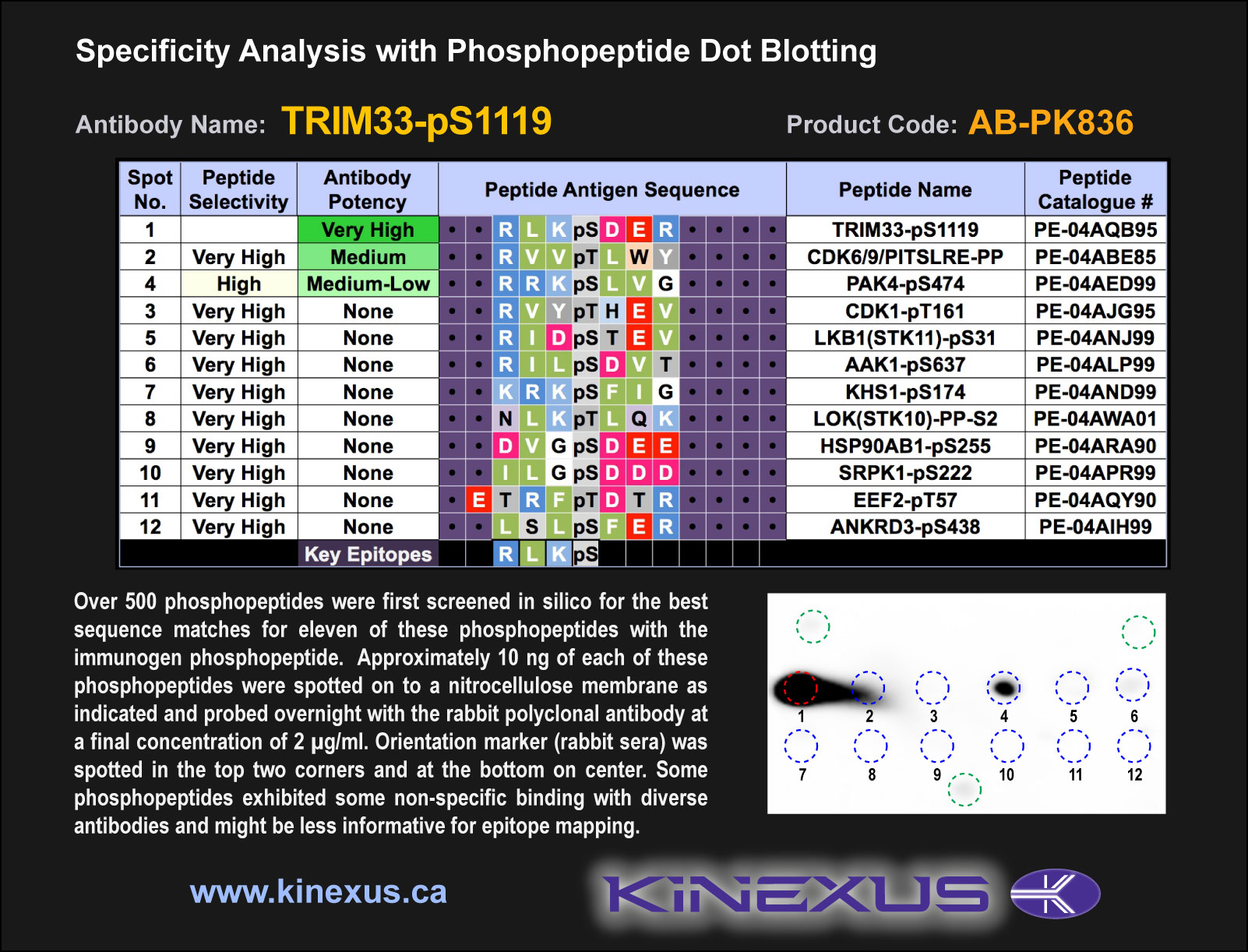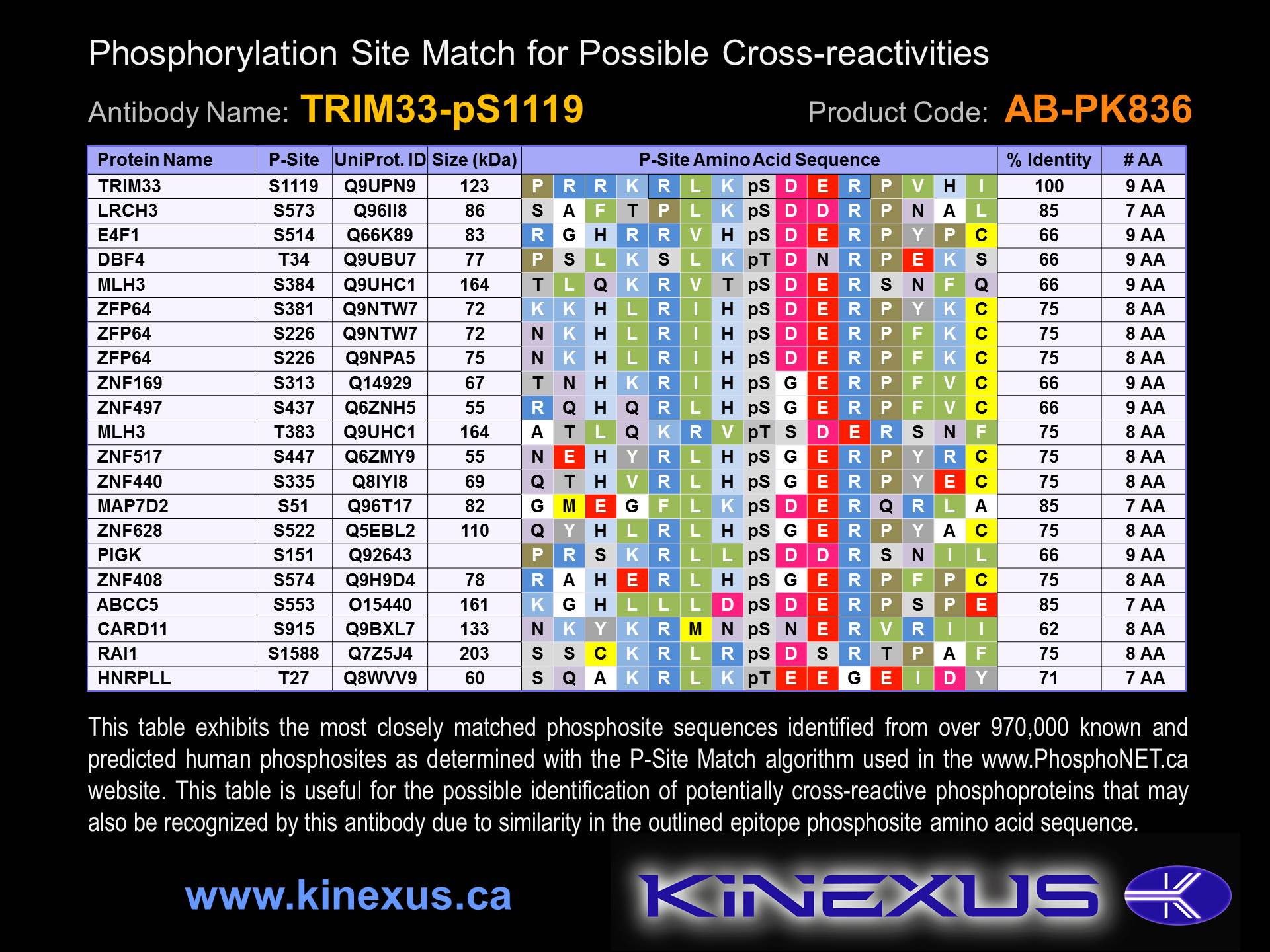Product Name: TRIM33-pS1119
Product Number: AB-PK836
| Size: | 25 µg | Price: | 89.00 | |
| $US |
Target Full Name: Transcription intermediary factor 1-gamma
Target Alias: FLJ11429; KIAA1113; PTC7; Ret-fused gene 7; RET-fused gene 7 protein; RFG7; Rfg7 protein; TRIM33; Tripartite motif-containing 33 (PTC7;TIF1G); TIF1GAMMA; FLJ32925; ENSG00000197323
Product Type Specific: Protein kinase phosphosite-specific antibody
Antibody Code: PK836
Antibody Target Type: Phosphosite-specific
Antibody Phosphosite: S1119
Protein UniProt: Q9UPN9
Protein SigNET: Q9UPN9
Antibody Type: Polyclonal
Antibody Host Species: Rabbit
Target Alias: FLJ11429; KIAA1113; PTC7; Ret-fused gene 7; RET-fused gene 7 protein; RFG7; Rfg7 protein; TRIM33; Tripartite motif-containing 33 (PTC7;TIF1G); TIF1GAMMA; FLJ32925; ENSG00000197323
Product Type Specific: Protein kinase phosphosite-specific antibody
Antibody Code: PK836
Antibody Target Type: Phosphosite-specific
Antibody Phosphosite: S1119
Protein UniProt: Q9UPN9
Protein SigNET: Q9UPN9
Antibody Type: Polyclonal
Antibody Host Species: Rabbit
Antibody Immunogen Source: Human TRIM33 (TIF1G) sequence peptide Cat. No.: PE-04AQB95
Antibody Immunogen Sequence: RLK(pS)DER(bA)C
Antibody Immunogen Description: Corresponds to amino acid residues R1116 to R1122; In C-terminus of kinase
Antibody Immunogen Sequence: RLK(pS)DER(bA)C
Antibody Immunogen Description: Corresponds to amino acid residues R1116 to R1122; In C-terminus of kinase
Production Method: The immunizing peptide was produced by solid phase synthesis on a multipep peptide synthesizer and purified by reverse-phase hplc chromatography. Purity was assessed by analytical hplc and the amino acid sequence confirmed by mass spectrometry analysis. This peptide was coupled to KLH prior to immunization into rabbits. New Zealand White rabbits were subcutaneously injected with KLH-coupled immunizing peptide every 4 weeks for 4 months. The sera from these animals was applied onto an agarose column to which the immunogen peptide was thio-linked. Antibody was eluted from the column with 0.1 M glycine, pH 2.5. Subsequently, the antibody solution was neutralized to pH 7.0 with saturated Tris.This antibody was also subject to negative purification over phosphotyrosine-agarose.
Antibody Modification: Unconjugated. Contact KInexus if you are interest in having the antibody biotinylated or coupled with fluorescent dyes.
Antibody Modification: Unconjugated. Contact KInexus if you are interest in having the antibody biotinylated or coupled with fluorescent dyes.
Antibody Concentration: 0.75 mg/ml
Storage Buffer: Phosphate buffered saline pH 7.4, 0.05% Thimerasol
Storage Conditions: For long term storage, keep frozen at -40°C or lower. Stock solution can be kept at +4°C for more than 3 months. Avoid repeated freeze-thaw cycles.
Product Use: Western blotting | Antibody microarray
Antibody Dilution Recommended: 2 µg/ml for immunoblotting
Antibody Potency: Very strong immunoreactivity with immunogen peptide on dot blots.
Antibody Species Reactivity: Human
Antibody Positive Control: The observed molecular mass of the processed target protein on SDS-PAGE gels is reported to be around 130-150 kDa.
Storage Buffer: Phosphate buffered saline pH 7.4, 0.05% Thimerasol
Storage Conditions: For long term storage, keep frozen at -40°C or lower. Stock solution can be kept at +4°C for more than 3 months. Avoid repeated freeze-thaw cycles.
Product Use: Western blotting | Antibody microarray
Antibody Dilution Recommended: 2 µg/ml for immunoblotting
Antibody Potency: Very strong immunoreactivity with immunogen peptide on dot blots.
Antibody Species Reactivity: Human
Antibody Positive Control: The observed molecular mass of the processed target protein on SDS-PAGE gels is reported to be around 130-150 kDa.
Antibody Specificity: High
Antibody Cross Reactivity: No significant cross-reactive proteins in HepG2 and MCF7 cells, except for medium 75 and ~48 kDa immunoreactive proteins.
Related Product 1: TRIM33-pS1119 blocking peptide
Antibody Cross Reactivity: No significant cross-reactive proteins in HepG2 and MCF7 cells, except for medium 75 and ~48 kDa immunoreactive proteins.
Related Product 1: TRIM33-pS1119 blocking peptide
Scientific Background: TRIM33 (TIF1g) is a protein-serine/threonine kinase of the Atypical group and TIF1 family. It functions as an E3 ubiquitin-protein ligase to promote SMAD4 ubiquination, nuclear exclusion, and degradation via the ubiquitin proteasome pathway. In particular, the TRIM33 protein inhibits the SMAD4 transcriptional responses to the TGF-beta/BMP signalling cascade, a key transducer of mitogenic signals. This is accomplished through the ubiquination and subsequent degradation of SMAD4, which prevents the formation of a transcription factor complex between SMAD4, SMAD2, and SMAD3. Therefore, TRIM33 plays a critical role in the regulation of cell proliferation as it influences cellular responsiveness to TGF-beta/BMP signalling. In addition, a protein complex consisting of the TRIM33, SMAD2, and SMAD3 proteins promotes the erythroid differentiation of hematopoietic stem/progenitor cells. It is predicted that the TRIM33-SMAD2/3 and SMAD4-SMAD2/3 protein complexes function as complementary effectors in the regulation of hematopoietic cell fate as mediated by the TGF-beta signalling pathway. TRIM33 appears to be an oncoprotein (OP) and a tumour suppressor protein (TSP). Several gain-of-function mutations affecting the TRIM33 gene have been observed in cancer patients, many involving chromosomal rearrangements with the TRIM33 gene.
Figure 1. Epitope mapping of TRIM33-pS1119 antibody with similar phosphopeptides on dot blots.
Figure 2. Identification of phosphosites related to TRIM33-pS1119.
© Kinexus Bioinformatics Corporation 2017



